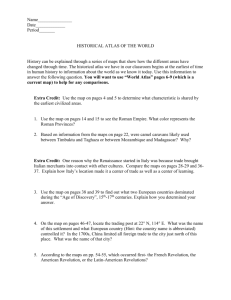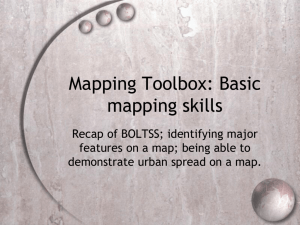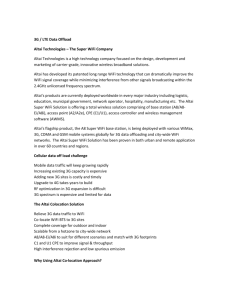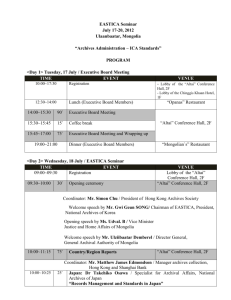Document 11841003
advertisement
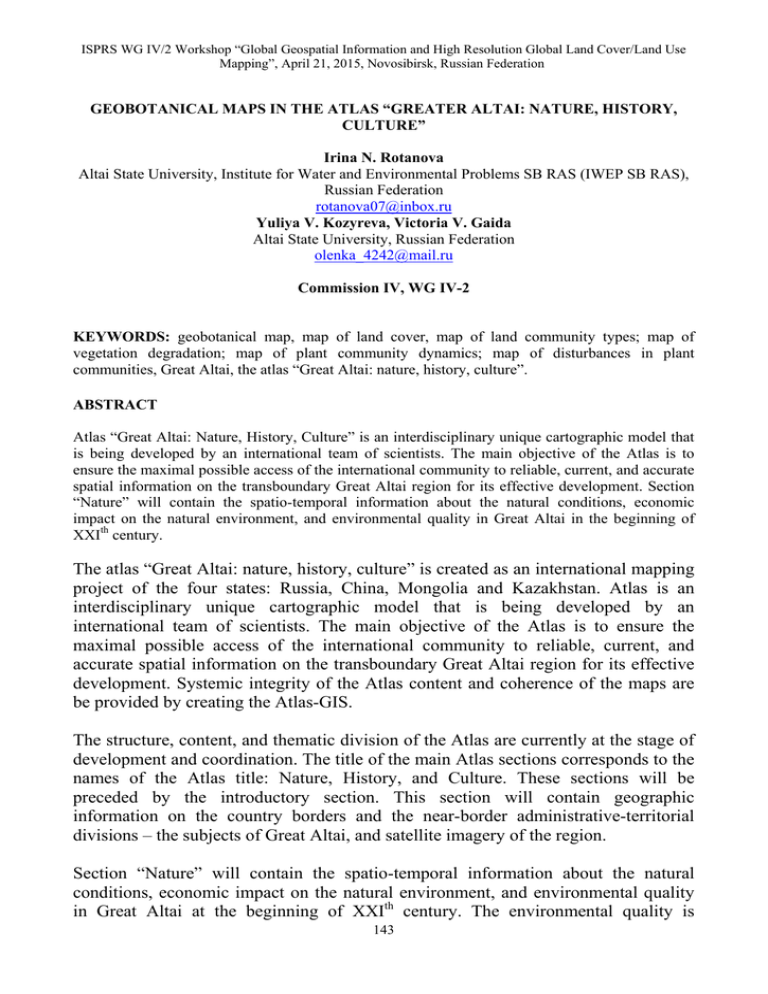
ISPRS WG IV/2 Workshop “Global Geospatial Information and High Resolution Global Land Cover/Land Use Mapping”, April 21, 2015, Novosibirsk, Russian Federation GEOBOTANICAL MAPS IN THE ATLAS “GREATER ALTAI: NATURE, HISTORY, CULTURE” Irina N. Rotanova Altai State University, Institute for Water and Environmental Problems SB RAS (IWEP SB RAS), Russian Federation rotanova07@inbox.ru Yuliya V. Kozyreva, Victoria V. Gaida Altai State University, Russian Federation olenka_4242@mail.ru Commission IV, WG IV-2 KEYWORDS: geobotanical map, map of land cover, map of land community types; map of vegetation degradation; map of plant community dynamics; map of disturbances in plant communities, Great Altai, the atlas “Great Altai: nature, history, culture”. ABSTRACT Atlas “Great Altai: Nature, History, Culture” is an interdisciplinary unique cartographic model that is being developed by an international team of scientists. The main objective of the Atlas is to ensure the maximal possible access of the international community to reliable, current, and accurate spatial information on the transboundary Great Altai region for its effective development. Section “Nature” will contain the spatio-temporal information about the natural conditions, economic impact on the natural environment, and environmental quality in Great Altai in the beginning of XXIth century. The atlas “Great Altai: nature, history, culture” is created as an international mapping project of the four states: Russia, China, Mongolia and Kazakhstan. Atlas is an interdisciplinary unique cartographic model that is being developed by an international team of scientists. The main objective of the Atlas is to ensure the maximal possible access of the international community to reliable, current, and accurate spatial information on the transboundary Great Altai region for its effective development. Systemic integrity of the Atlas content and coherence of the maps are be provided by creating the Atlas-GIS. The structure, content, and thematic division of the Atlas are currently at the stage of development and coordination. The title of the main Atlas sections corresponds to the names of the Atlas title: Nature, History, and Culture. These sections will be preceded by the introductory section. This section will contain geographic information on the country borders and the near-border administrative-territorial divisions – the subjects of Great Altai, and satellite imagery of the region. Section “Nature” will contain the spatio-temporal information about the natural conditions, economic impact on the natural environment, and environmental quality in Great Altai at the beginning of XXIth century. The environmental quality is 143 ISPRS WG IV/2 Workshop “Global Geospatial Information and High Resolution Global Land Cover/Land Use Mapping”, April 21, 2015, Novosibirsk, Russian Federation considered as a result of economic, social, and cultural development of near-border administrative-territorial entities of the four countries located within the Altai mountain system. Section “Nature” will have three major subsections: Natural conditions; the impact of economic activity on the environment; sustainable territorial development; protection and optimization of natural environment. The maps included into the section “Natural conditions” will have three major topics: Landscapes. Ecological Potential of Landscapes. Climatic division into districts. Comfort of climate. Hydrological areas. Glaciers and mudflows. Permafrost: distribution, temperature, power. Seasonal frost penetration and thawing. Types of plant communities. Land cover changes. Disturbances in plant communities. The atlas “Great Altai: nature, history, culture” includes the following geobotanical maps: • Vegetation types • Land cover degradation • Disturbances in plant communities. A systematic (geosystems) approach to study the organization of ecosystems’ plant community components, with basic theoretical positions laid in the works by V.B. Sochava provide high ecological information richness of maps. They contain information about environmentally relevant geographical factors that determine the structure and vegetation dynamics at different levels of its organization, the dynamic and environmental potential of the area occupied by specific plant taxa, and much more. The diversity and features of the subject scope were defined for each group of maps. Geobotanical maps reflect the ecological and resource potential of a territory - a number of conditions and resources of the environment (geosystems, region), which ensures the existence of a human and is essential for his business activity. The maps being created fall into the category of evaluation maps. They are based on the information of inventory maps and characterize the compliance of natural environment states and conditions with certain (specified) criteria or standards. The central position occupied by vegetation maps in the Atlas “Greater Altai: nature, history, culture”, results from the fact that it is vegetation which largely determines the ecological state of a territory. Although there are other biogeographical maps of great scientific and practical importance aimed at solving ecological and geographical problems. 144 ISPRS WG IV/2 Workshop “Global Geospatial Information and High Resolution Global Land Cover/Land Use Mapping”, April 21, 2015, Novosibirsk, Russian Federation Vegetation dynamics, its variability under the influence of internal and external factors, on the one hand, provides a variety of forms for its coenotic organization and types of connections and relationships with the living environment, including anthropogenic factor here; on the other hand - it is a condition of its evolution occurring in close connection with the historical development of the entire landscape and geographical environment. In the application context the cartographic study of vegetation stabilizing function is important to identify the stability limits of biotic communities to natural, and especially, to anthropogenic factors. Potential assessment of anthropogenic stability of vegetation within natural complexes of different taxonomic rank allows normalizing the anthropogenic influence to prevent the development of irreversible destructive processes in natural complexes, which is necessary for forecasting and recommendation development within the ecological and geographical works. Within the system of ecological and geographical assessments of vegetation the central position is given to identifying and assessing various aspects of its complex and diverse geosystem-forming functions – productional, stabilizing, regulatory, protective, etc. - and determining its role in development and operation of many processes and phenomena. The peculiarities of vegetation mapping are determined primarily by modern concepts of the systemic nature of its organization as an integral part and the most important component of landscape and geographical environment, largely determining its development and spatial differentiation This work was financially supported by RFBR (project 15-05-09421). Contact: Dr. Irina N. Rotanova Altai State University, Institute for Water and Environmental Problems SB RAS (IWEP SB RAS), Russia 1, Lenina Av. Barnaul, 656049 Russian Federation Office/Fax: 007-3852-29-12-75 E-mail: rotanova07@inbox.ru 145

